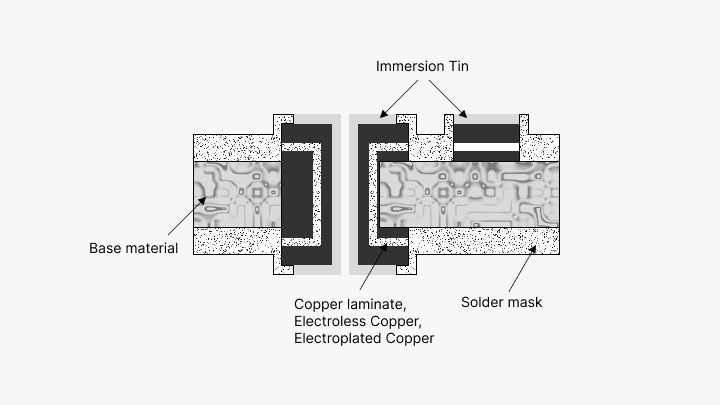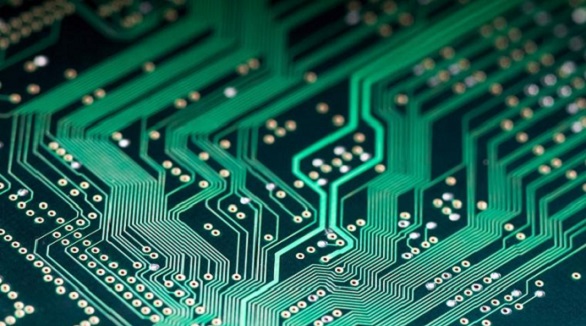What is Immersion Tin on a PCB?
Immersion tin finishes protect PCB copper traces from oxidation, offering excellent solderability, long shelf life, and RoHS compliance. Cost-effective and reliable, it's widely used in consumer electronics, automotive, telecoms, and industrial controls.
The immersion tin, also known as white tin, serves as a surface finish for printed circuit boards,protecting the copper traces and pads from oxidation and corrosion. It provides a flat solderable surface for mounting components, and due to several advantages, it has gained much popularity in the field of PCB manufacturing.
Immersion Tin is a plating process applied to the exposed copper traces, contact fingers, pads, and vias on a printed circuit board or PCB. This finish is accomplished by immersing the PCB in a heated aqueous solution of tin containing the following key chemicals:
Stannous Chloride (SnCl2): Provides soluble tin ions.
Reducing Agents: Promote the reduction of tin ions.
Complexing Agents: Prevents precipitation of tin.
pH Buffers, Stabilizers, and Wetting Agents: maintain the stability and effectiveness of the solution.
In immersion, copper on a PCB interacts directly with the solution to replace the copper atoms with the tin atoms through some sort of electroless plating. A thin, even layer of tin covers the exposed copper surfaces without the need for an external electrical current.

Advantages of Immersion Tin
Some of the key advantages of Immersion Tin over other finishes are as follows:
Solderability: The tin finish offers easy wetting and soldering, similar to that of a bare copper finish; thus, it is reliable for many assembly methods.
No Shelf Life Issues: Unlike in the case of silver or copper, the tin does not degrade or oxidize with time, thus ensuring long-term reliability.
Less Whisker: Pure tin avoids the whisker growth of tin-lead, one of the problems concerning HASL.
RoHS Compliance: Immersion Tin does not contain any lead or toxic materials, hence meeting strict environmental regulations.
Cost-Effective: It is less expensive than ENIG, hence cost-effective in a lot of applications.
No Electrochemical Migration: Immersion Tin prevents copper ion leaching effects normally found in OSP coatings.
Immersion Tin Plating Process
Below is a step-by-step overview of Immersion Tin plating:
Pre-cleaning: The PCB is dipped in an acid solution to remove oil, grease, and other impurities. It is then washed with water to remove residual cleaning agents.
Microetching: It is a process where the board is dipped in a solution containing sulfuric acid (H2SO4) to make the surface of copper more irregular so that the tin layer can adhere to it better. Again, it undergoes water rinsing to remove the residual acid.
Pre-immersion: In this process, the PCB undergoes an acid wash to avoid its early oxidation of the copper surface. A clean base for deposition results for tin.
Immersion Tin: The board is immersed in the solution containing tin. In this case, the cations of tin act as an accelerator of the process of electroless reduction, resulting in a thin layer of flat tin on the copper pad.
Rinsing: The PCB is washed with warm water to remove the salts of the plating that may eventually give it stains or unwanted marks.
Drying: This is the final stage, where the board is dried from moisture. This may be done by using clean forced air or by oven bake at warm temperatures, taking care not to bake for too long and at the right temperature to keep the integrity of the board.
| Finish | Solderability | Shelf Life | Whiskering | Cost |
| Immersion Tin | Excellent | Years | None | Medium |
| HASL | Fair | Medium | Severe | Low |
| ENIG | Fair | Short | None | High |
| OSP | Poor | Short | None | Low |
| Immersion Sliver | Excellent | Short | None | Medium |
Applications of Immersion Tin
Immersion Tin finds itself in many fields thanks to its strong properties, such as:
Consumer Electronics: Supplies solid, reliable connections for mobile telephones, tablets, and similar devices.
Automotive Electronics: Withstands the unfriendly conditions that typify automotive atmospheres.
Telecommunications: Used in high-density networking equipment where superior solderability and flat surfaces are highly critical.
Industrial Controls: Offers consistent, reliable operations under the unique stresses of contemporary industrial service.
Conclusion
Immersion Tin is a modern, cost-effective form of finish, with very good solderability and long-term reliability. Its process is conducted under strict conditions so that the best quality results are achieved; hence, it finds widespread acceptance for use in many fields. With the knowledge of the advantages and detailed procedures regarding Immersion Tin plating, study and decision-making by a PCB designer or engineer will definitely enhance performance in their electronic products.
Hot Tags:
Contact us

If you can't find what you're looking for, please contact us.
Article

The trend towards lead-free PCB manufacturing comes due to the EU's ROHS directive, which requires compliance to the limits on the content of lead. Compliance with lead-free is achieved by different surface finishes such as ENIG, ImAg, ImSn, and OSP—all with their different pros and cons. This paper compares these finishes to help choose the best for specific PCB applications.

Most electronic circuits are mounted on PCBs, or Printed Circuit Boards, which provide mechanical support and electrical interconnection of electronic components. There are, however, special applications that involve the use of single and double-sided PCBs, multi-layer PCBs, or even rigid and flexible PCBs with aluminum backing, targeting medical, industrial, auto, and aerospace industries. They may use materials such as fiberglass, epoxy, aluminum, and others.

Aluminum PCBs are widely used electronic boards with comparatively better heat dissipation properties. The aluminum core cools down the components of the product, thereby improving its performance. These are eco-friendly, light, and strong PCBs and hence appropriate to be used in audio equipment, power supplies, and lighting products such as LED lighting.